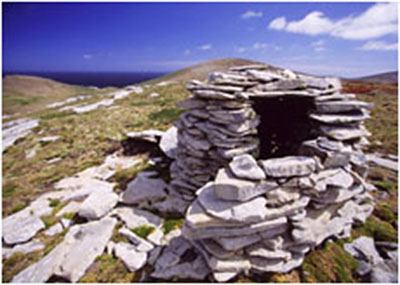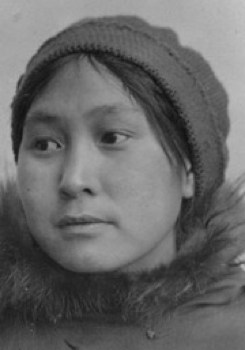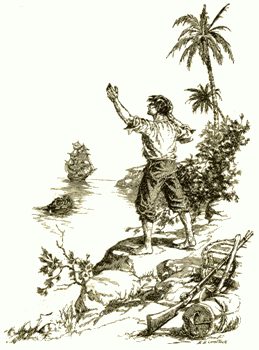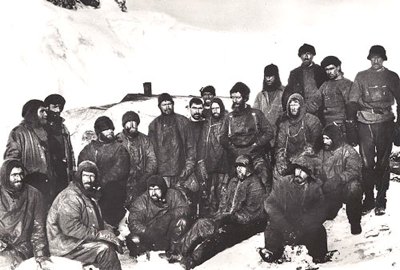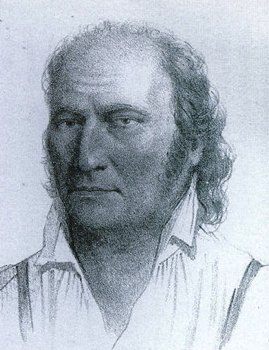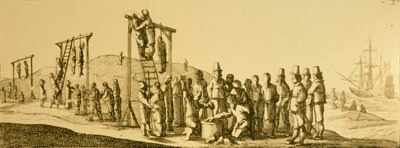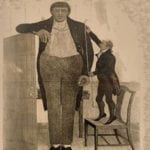Survived: 6 days on Plum Pudding and Olasana Islands In 1943, John F. Kennedy was the 26-year old skipper of PT-109. As the PT-109 was prowling the waters late at night a Japanese destroyer suddenly emerged and in an instant, cut Kennedy’s craft in half. Two of his 12 member crew were killed instantly and two others badly injured. The survivors clung to the drifting bow for hours. At daybreak, they embarked on a 3.5 miles (6 kilometers) swim to the tiny deserted Plum Pudding Island. They placed their lantern, and non-swimmers on one of the timbers used as a gun mount and began kicking together to propel it. Braving the danger of sharks and crocodiles they reached their destination in five hours. After two days on the small island without food and water, Kennedy realized they needed to swim to a larger island, Olasana, if they were to survive. Kennedy and his men were found and rescued by scouts after surviving six days on coconuts. Interesting Fact: The island where Kennedy’s crew washed ashore has become a minor attraction, and has been renamed Kennedy Island.
Survived: around 6 months on the Ascension Islands Leendert Hasenbosch was a Dutch soldier who went aboard a VOC-ship as the bookkeeper. After the ship made a stop at Cape Town in 1725 he was sentenced for sodomy and set ashore on Ascension Island. He was given a tent and the amount of water for about a month, some seeds, a bible, clothing and writing materials. Hasenbosch survived by eating sea turtles and seabirds as well as drinking his own urine. It is believed he probably died in a terrible condition after about six months. Interesting Fact: Leendert Hasenbosch wrote a diary that was found by British mariners in 1726 who brought the diary back to Britain. The diary was rewritten and published a number of times. One of the sad entries is pictured above. (Translated from Dutch to English)
Survived: 2 years on Isle of Demons In 1542 French explorer Jacques Cartier led a voyage to Newfoundland, accompanied by 19 year old Marguerite, de La Rocque. During the journey, Marguerite became the lover of a young man. Displeased with her actions Marguerite’s uncle, Lieutenant General and pirate Jean-François Roberval (pictured above) marooned her on the “Isle of Demons” (now called Harrington Island) near the Saint-Paul River. Also marooned were Marguerite’s lover, and her maid-servant. Marguerite gave birth to a child while on the island but the baby died, (probably due to insufficient milk), as did the young man and the maid servant. Marguerite survived by hunting wild animals and lived in a cave for two years until she was rescued by Basque fishermen. Interesting Fact: Returning to France after her rescue, Marguerite achieved some celebrity when her story was recorded by the Queen of Navarre in 1558.
Survived: 18 months on Eagle Island (Part of the Falkland Islands). In 1812, the British ship Isabella, was shipwrecked off Eagle Island. Most of the crew was rescued by the American sealer Nanina, commanded by Captain Charles Barnard. However, realizing that they would require more provisions for the extra passengers, Barnard and four others went out to retrieve more food. During their absence the Nanina was taken over by the British crew. Barnard and his men were left on Eagle Island by the very men they had saved. Barnard and his party were finally rescued in November 1814. The photo (pictured above) is a stone shelter built by Captain Barnard as a lookout for passing ships. Interesting Fact: The evening of the rescue Barnard dined with the Isabella survivors and finding that the British party was unaware of the War of 1812 informed the survivors that technically they were at war with each other. (Maybe he shouldn’t have mentioned that). Barnard later wrote a narrative ‘Marooned’ detailing his experience.
Survived: 2 years on Wrangel Island In the fall of 1921 a team of five people were left on Wrangel Island north of Siberia. Arctic explorer Vilhjalmur Stefansson planned the expedition with the intention of claiming the island for Canada or Britain. A 23 year old Eskimo woman Ada Blackjack was hired as a cook and seamstress and was paid 50 dollars a month. Ada needed the money for her son who was suffering with tuberculosis. The plan was to stay one year on the Island and bring six months’ worth of supplies. This would be enough to sustain them for a year while they lived off the land itself. The men were unable find enough food and began to starve so in January 1923 three of the men made a desperate attempt to seek help. Ada was left to care for the fourth man who was sick with scurvy. The three men were never heard from again and the man she was caring for eventually died. Ada somehow learned how to survive until she was rescued in August 1923 by a former colleague of Stefansson’s. Ada used the money she earned to take her son to Seattle to cure his tuberculosis. Interesting Fact: Except for the salary that Ada made on the trip and a few hundred dollars for furs that she trapped while on Wrangel Island, Ada did not benefit from the subsequent publication of several very popular books and articles concerning her survival story.
Survived: 4 years and 4 months on Más a Tierra Island Alexander Selkirk was a Scottish sailor and a skillful navigator which led to his appointment as a Sailing Master on the ‘Cinque Ports. The captain of the ship was a tyrant and after a few sea battles with the Spanish, Selkirk feared the ship would sink. So in an attempt to save his own life he demanded to be put ashore on the next island they encountered. In September 1704, Selkirk was dropped off on the uninhabited island of Más a Tierra over 400 miles off the West Coast of Chile. He took with him some clothing, a musket, some tools, a Bible and tobacco. At first Selkirk simply read his Bible awaiting rescue, but it soon became apparent that the rescue wasn’t imminent. He resigned himself to a long stay and began to make island life habitable with only rats, goats and cats for company. Finally on February 1709, two British privateers dropped anchor offshore and Alexander Selkirk was rescued. In 1713 Selkirk published an account of his adventures which many believe were fictionalized six years later by Daniel Defoe in his now famous novel: Robinson Crusoe. Interesting Fact: In 1966 Más a Tierra Island was officially renamed Robinson Crusoe Island. At the same time, the most western island of the Juan Fernández Islands was renamed Alejandro Selkirk Island.
Survived: 105 days on Elephant Island Ernest Shackleton was an Anglo-Irish explorer and launched the Imperial Trans-Antarctic Expedition in 1914. During the expedition the ship “Endurance” became trapped in ice and for 10 months drifted until the pressure of the ice crushed and sank the ship. Shackleton and his men were stranded on ice floes where they camped for five months. The men sailed three small lifeboats to Elephant Island which was uninhabited and provided no hope for rescue. Shackleton and five others set out to take the crew’s rescue into their own hands. In a 22-foot lifeboat they survived a 17-day, 800-mile journey through the world’s worst seas to South Georgia Island, where a whaling station was located. The six men landed on an uninhabited part of the island so their last hope was to cross 26 miles of mountains and glaciers (considered impassable) to reach the whaling station on the other side. Shackleton and two others made the trek and arrived safely in August 1916. (21 months after the initial departure of the Endurance). With the help of the Chilean government and its navy, Shackleton returned to rescue the men on Elephant Island. Not one member of the 28-man crew was lost. Interesting Fact: It would be more than 40 years before the first crossing of Antarctica was achieved, by the Commonwealth Trans-Antarctic Expedition, 1955–58.
Survived: on the Pitcairn Islands After the famous mutiny in 1789 and several months of landing and sailing around the eastern islands of Fiji the Bounty mutineers decided to settle on the uninhabited Pitcairn Islands to elude the Royal Navy. To prevent the ship’s detection, and anyone’s possible escape, the ship was burned to the water. Nine crewmen along with six Tahitian men, and 11 women, one with a baby had found a home. The Tahitians were treated poorly which led them to revolt and kill some of the mutineers. By 1794 crewmen Young, Adams, Quintal and McCoy were left for a household of ten women and their children. McCoy who had once worked in a distillery discovered how to brew a potent spirit from the roots of the ti plant. By 1799, Quintal had been killed by Young and Adams in self defense and McCoy had drowned himself. Adams and Young turned to the Scriptures using the ship’s Bible as their guide for a new and peaceful society. As a result, Adams and Young converted to Christianity and taught the children to read and write using the Bible. Then in 1800, Young died of asthma, leaving John Adams as the sole male survivor of the party that landed just ten years earlier. Interesting Fact: Later in 1808 the ship “Topaz” arrived at Pitcairn Island and found Adams ruling over a peaceful community of ten Tahitian women (including his wife) and several children. The Royal Navy granted him clemency in 1825, and he died four years later. Also: The main settlement and capital of Pitcairn, Adamstown, is named for John Adams.
Survived: (Unknown) on the Australia mainland In 1629 a Dutch East India ship Batavia, with 316 people on board, was wrecked off the coast of Western Australia. Most of the people on board made it safely to the near by Abrolhos islands. A fanatic named Jeronimus Cornelius led a mutiny and with 36 men under his command began systematically murdering, raping and torturing men women and children. Before help arrived, 125 people had been murdered and their bodies dumped in mass graves. Cornelius and other mutineers had their hands cut off after they signed a confession and then hanged. Two of the youngest of the mutineers, Wouter Loos, and Jan Pelgrom avoided execution when they were sentenced to be marooned on the Australian mainland. They were given some provisions and put ashore near the mouth of the Murchison River and were told to explore the land and to try and make contact with Aborigines. They were instructed to keep watch for a vessel to take them off after two years. They were never seen again, and might be considered as Australia’s first known European residents. Interesting Fact: Later European exploration recorded Aborigines with blue eyes, suggesting at least one of the men survived. Also: The mass graves were later excavated and became a morbid tourist attraction. The story is frequently taught in schools and has even been made into an opera.
Survived: 18 years on San Nicolas Island In 1835 Russian sea otter hunters clashed with Indian people living on remote San Nicolas Island. The bloody conflict drastically reduced the native population. Missionaries requested that these Indians be moved to the mainland for their own safety. When a ship was sent to pick them up high winds forced it to depart early leaving Juana Maria behind. In 1853, a party headed by sea otter hunter George Nidever found the Indian woman alive and well. Clad in a dress of cormorant skins sewn together, she lived in a shelter made from whale bones. She willingly went with her rescuers bringing along only a few possessions. Nidever brought her home to live with him and his wife in Santa Barbara, California. No one, including the local Chumash Indians could understand her language. The new living conditions altered her diet and affected the woman’s health. She contracted dysentery and died after she had been on the mainland for only seven weeks. The Lone Woman was baptized conditionally with the Christian name Juana Maria (her Indian name is unknown) She is buried at Mission Santa Barbara where a plaque (pictured above) remains in her memory. Interesting Fact: Juana Maria’s life story was turned into a book “Island of the Blue Dolphin”



